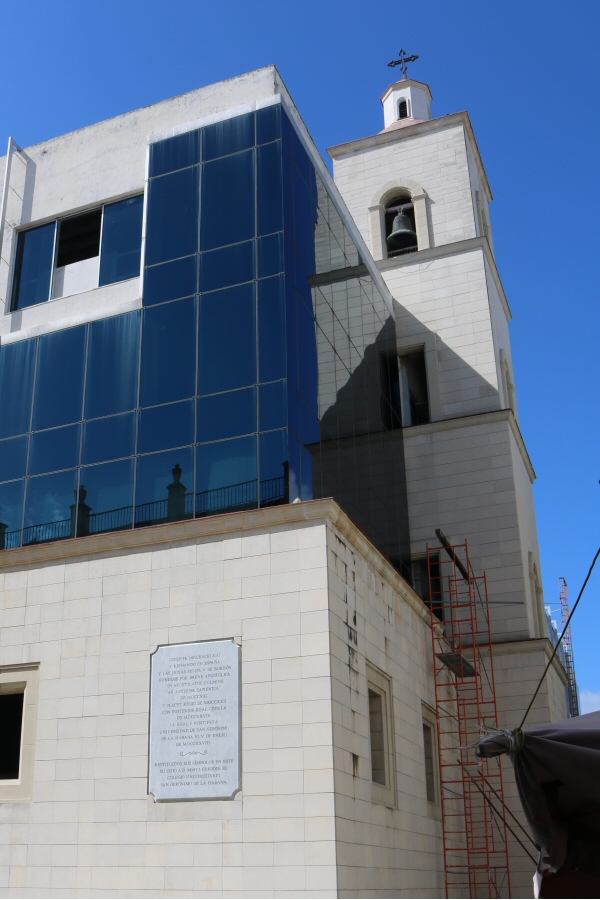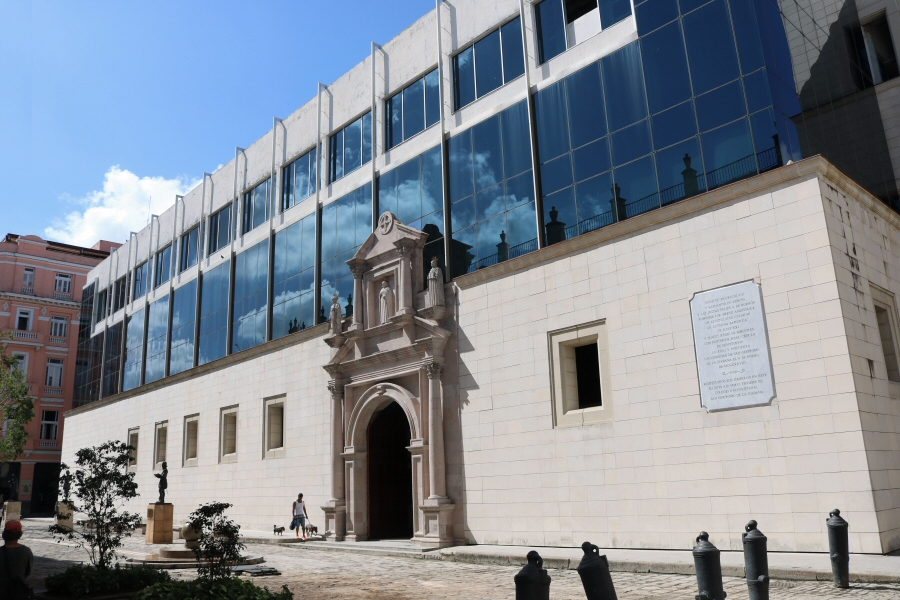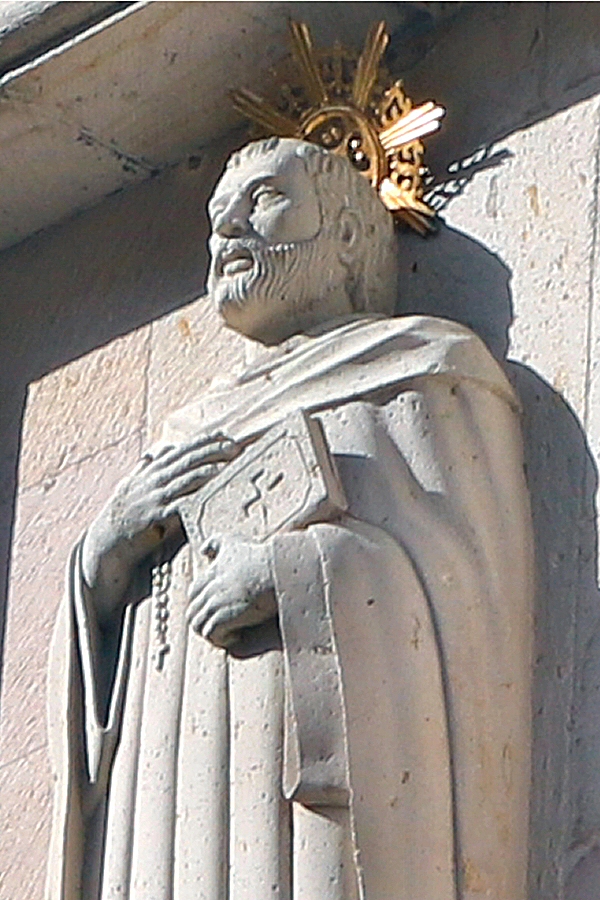
Convento de Santo Domingo
HISTORY
During the years the construction
changed by modifications and additions, so that the evolutionary
process reached the fullness at the end of the 18th century. In
the mid-18th century the church, built in stone, had only one
nave and three cloisters, of which the first was constructed
with columns and carved stone arches, but the other two were
made of wood with spaces for classrooms and offices for the
friars. The building had a long and wide, splendidly carved
wooden roof and covered with tiles.
In the second half of the 18th century the architect Ignacio José Balboa added the baroque side facade on the Mercaderes street to the building. The statue of Santo Domingo de Guzmán, the patron of the Order of Preachers, carved in stone, was placed in a niche over the side door that was topped by a semicircular arch. The statues of Saint Thomas Aquinas and St. Peter Martyr, placed on columns, were guarding the side entrance. Saint Thomas Aquinas (1224-1275) was an Italian Dominican friar, immensely influential philosopher, theologian and the greatest thinker of the Scholastic School. He incorporated Aristotle’s ideas into Christianity. St. Peter Martyr (1206-1252) was an Italian Dominican friar that served as inquisitor. He was killed by an assassin and was canonized as a Catholic saint 11 months after his death, making this the fastest canonization in history. All the statues were in landscape proportions. The rest of the side facade looked clean and sober. Because of the unique composition of the side facade, the pristine main door, facing O’Reilly street door, was preferred by the faithful less frequent than the side door; maybe also, because it provided more comfortable and fast entrance and exit.
 Another important addition was the dome
with lantern that was dedicated to Our Lady of Rosary. The
exterior surface of the dome was covered with bluish green
ceramic slabs; a feature, that drew considerable attention. It
was not a particularity of Cuban churches, but of Mexico. In the
last quarter of the 18th century the distinctive feature of the
building was its bell tower that was one of the highest in the
city of the time. It was erected at the north side of the
building and over the semicircular main door.
Another important addition was the dome
with lantern that was dedicated to Our Lady of Rosary. The
exterior surface of the dome was covered with bluish green
ceramic slabs; a feature, that drew considerable attention. It
was not a particularity of Cuban churches, but of Mexico. In the
last quarter of the 18th century the distinctive feature of the
building was its bell tower that was one of the highest in the
city of the time. It was erected at the north side of the
building and over the semicircular main door.
In the first half of the 18th century
the Dominican friar that were concerned in the education system
of the island, requested for the permission to start with the
studies in their convent. At that time, children of wealthy families had to go
Mexico, Santa Domingo or Spain to receive education. In 1721,
the Dominican friars obtained the approval of founding an
university in their convent, Convento de
San Juan de Letrán,
also known as Convento de Santa Domingo, by the bull issued by
Pope Innocent XIII. Counts of Bayona had great support in this
event. In 1728 King Philip V of Bourbon confirmed by a Royal
Decree the establishment of the Real y Pontificia Universidad de
San Gerónimo de La Habana in the renovated convent. This was the
first university in Cuba and one of the first universities
founded in the Americas. This date is accepted as the date of
the establishment of the modern University of Havana today.
Except the short period in 1762 in that the invading British
army used the building as barracks, many children of wealthy
families received education in the fields of laws, medicine,
mathematics, grammar, theology and philosophy, attending the
five faculties of the university until 1841. The prominent
personalities of Cuban thought, science and culture that studied
in this university are Felix Varela, Manuel de Céspedes,
Francisco Vicente Aguilera, Ignacio Agramonte, Francisco de
Arango y Parreňo, Tomás Romay, José Augustín Caballero, Antonio
Bachiller y Morales, José María Heredia, Rafael María de Mendive,
José Antonio Saco and Cirilo Villaverde.
By passage of time, the Dominicans lost
their power, and finally also the possession of their property,
so that they could not continue with the education that was
their main activity as tutors. In 1841 their building passed
into the hands of the state, and when the administration of the
university was undertaken by the Spanish government, the
university was called Real y Literaria in 1842. It was no longer
a religious institution and changed its status to become a
secular, royal and literary institution.
The Convento de Santo Domingo (Convent of Santa Domingo) is located on the Mercaderes street, between the Obispo and the O’Reilly streets, just behind the Palacio de los Capitanes Generales. Currently, the building is occupied by the Colegio Universitario San Gerónimo de La Habana.
 The
Order of Preachers, also known as Dominican Order and its
members as Dominicans, and in France as Jacobins, is a mendicant
Order of the Roman Catholic Church, founded by Domingo de Guzmán
(Saint Dominic) in Toulouse during the Albigensian Crusade, and
confirmed by Pope Honorius III in 1216.
The
Order of Preachers, also known as Dominican Order and its
members as Dominicans, and in France as Jacobins, is a mendicant
Order of the Roman Catholic Church, founded by Domingo de Guzmán
(Saint Dominic) in Toulouse during the Albigensian Crusade, and
confirmed by Pope Honorius III in 1216.
Domingo de Guzmán was notable for his
learning and love of poverty. His Order had two characteristics:
instead of manual labor, as practiced by the Cistercian monks,
he required his friars to work with their minds by preaching and
teaching. Thus, the Dominicans were particularly dedicated to
preaching and excelled in the field of theology. Many members of
the order took part in the Medieval Inquisition.

